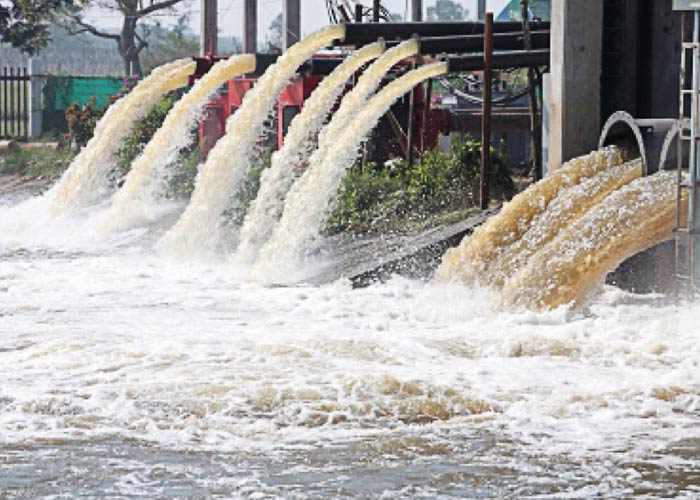Climate change is one of the most formidable challenges of our times. In fact, the threat from climate change is increasing for world economies and societies. The changing climate pattern around us finds its reflection in the rising phenomena of floods and droughts, extreme seasonal conditions; desertification, and elevation of sea level.
This cumulative scientific evidence emphasizes the need for initiating urgent action. Around the world, we are facing certain threats which have had their devastating effects on climate change. Environmental protection and climate change have affected the whole world.
The protection of environment is very important for present as well as future generations. Environmental protection can be achieved in the right way. There is a unique relationship between climate change and life. Unfortunately, some people believe that only the government and the big companies in general should do something for the protection of the environment. This is not true. In fact, every person can protect the environment from pollution, residues, all kinds of wastes and increasing population. In fact, the responsibility of taking measures to reduce the temperature of the Earth rests with every citizen of the world. Everyone should have the responsibility and authority to take care of the environment.
How to Prevent Climate Change (Climate Change Solutions):
What are the ways to control climate change? Here is the latest on the front of climate change solutions:
- Global Efforts for Reducing Carbon Emissions
The whole world is concerned about climate change, rise in global temperature and natural calamities. It is not that mankind can choose environment or growth/ development. We can achieve both of them. We must strike the right balance between human development and the need for conservation of natural resources.
For instance, the UK is moving towards green development. It is on track to reduce the emissions of harmful greenhouse gases by up to 80% by 2050. This change has come about also due to Climate Change Act 2008 of the Parliament of the United Kingdom, the world’s first climate law, which provides a legal basis for the low-carbon emissions. Britain aims to reduce costs of development and move faster in the field of innovative efforts and technology. In fact, due to Britain, all Europe is bound to adopt high standards. It is persuading the EU to reduce the 40% reduction in the emission level of by 2030.
In order to encourage lower costs, lower carbon-growth, Europe has now developed some state-of-the-art economic instruments, from product standards to selection and business, from CO2 to renewable energy targets. It has formed Green Growth Group which includes ministers from like-minded countries including Germany, France, Italy, Spain, UK and Sweden. Together they are working on low-carbon development policies.
But Europe, which adopts green growth, is not alone. Global investment in clean energy has increased nearly six-fold since 2004, almost 195 billion Euros annually. China’s investment between 2011 and 2015 is more than $ 12 trillion ($ 1.2 trillion) in its own green economy.
The US record is investing in clean energy is quite impressive as it has become the world’s largest investor in low carbon energy research and development.
This is truly inspirational for the Earth. And it is suggested that the world’s two largest pollutants, China and America, will be a big partner in producing low carbon in the future. No country can remain behind in the global low-carbon revolution because the future is of low carbon.
Significantly, British Secretary of State for Energy and Climate Change Edward Davey on his 2014 India visit, praised Ahmedabad for demonstrating the way forward: from being the third most polluted city in India in 2005, to receiving environmental awards for sustainable transport, urban planning and waste management. According to the minister, Ahmedabad showed an incredible track record of green growth due to decreasing pollution and increase in renewable energy.
- Watershed Management
With higher temperature, crops require more irrigation. The protection of moisture in the land and the accumulation of rain water are useful and helpful steps for continuous irrigation. Through watershed management, we can accumulate rain water and use it for irrigation. This helps us to get irrigation facility on one side and on the other hand, it ensures ground water recharge.
- Organic and Integrated Farming
With the use of chemical fertilizers and pesticides in the fields, soil productivity decreases. As their residues are carried through the food chain, it given rise to many types of diseases. Chemical farming also results in emissions of green gases. Therefore, we should put maximum emphasis on organic farming techniques.
Farmers can help in keeping the environment balanced by organic farming. Organic farming is also necessary for fertilization of the soil. Farmers, throughout the country, burn stubble of crops while it is organic manure in itself and it is important for the next crop. It is also a nutritious diet for animals, so it should not be burnt. Due to the tradition of burning crops of residues on fields in various countries, the next crop is damaged and the fertilizer capacity of the farm also decreases.
Also, instead of single agriculture, we should adopt aggregate cultivation method. In single cultivation, the risk is high, whereas in the aggregate cultivation, it is very much reduced. Various crops are produced in aggregate cultivation, so that if a crop gets destroyed due to some reasons, then the second crop of the farmer can sustain him.
- Development of New Crops
To moderate the long-term impact of climate change, there is a need to develop varieties of seeds that are suitable for new climate. We have to develop varieties that are capable of tolerating high temperature, drought and flooding of the environments. We also have to invent the varieties which tolerate salinity and alkalinity.
- Changes in Crop Combination
In addition to climate change, we will also have to make changes in the crop format and the time of planting. With mixed farming and inter-cropping, the risks of climate change can be dealt with. By adopting agricultural forestry, we can reduce the dangers of climate change.
- Proper Utilization of Natural Resources
By 2050, the world’s population will be approximately 9.5 billion, which clearly means that we have to create 70 percent more food for two billion additional people. Therefore, the food and agriculture system will have to adapt to climate change and it will need to be more flexible, fertile and sustainable. For this, proper utilization of natural resources has to be done along with reduction in losses due to farming. At the same time, the process of harvesting, storage, packaging and transportation, necessary infrastructure needs and marketing processes, etc need to be improved.
Given this, the main theme of World Food Day 2016 was ‘Climate is changing. Food and Agriculture should also be transformed’. It was organized to encourage people to focus on sustainable ways of food production, i.e., adopting practices that lead to produce more food by making rational use of natural resources. By 2030, there is a global goal of achieving ‘zero hunger’ level, which cannot be achieved without solving climate change and food security.
- Energy saving and using clean energy
It is the simplest and effective method of controlling the Earth’s heat. For instance, LED bulbs should be distributed for power saving, and the people should start taking solar energy as a mission. Since increase in the emissions of greenhouse gases is a major reason for climate change, it is important to ensure reduction in their emissions to improve the environment.
- Need for Recycling
Almost all things can be recycled: glass, paper, plastic or metal, tyres, textiles, and electronics. Things such as broken jars, liquor bottles, glasses and any other thing made of glass and which is no longer useful can be recycled. Similarly, the old newspapers, soiled papers, cardboards etc can also be recycled.
- Reduce Water Consumption
Water is life. Clean and fresh water is becoming more and more valuable over time and if we are not doing anything to save it so far, then water in future will be more valuable than gold. That is why it is important that we should do whatever we can to save it and to prevent its pollution with greater efforts. Whenever we brush, let’s keep the tap off, use less water during bath; use the washing machine only when the clothes are too many. Similarly, oil and colour should not be flown in the drains, because they pollute the rivers and finally the sea.
- Reduce the Use of Electricity
Once we have used an electrical appliance, we should immediately turn it off. This will save not only our electricity bill but also conserve energy. To save energy, LED bulbs have arrived nowadays, so it is good idea to replace our old bulbs with them. Once we leave the office, we should turn off our computers and monitors. By doing this, we will help in reducing the power consumption.
- Plant More and More Trees
Trees are the largest source of oxygen and we cut them instead of growing them. If every person on the Earth plants a tree, then life would improve significantly, the air will become clearer; the number of trees will return to normal; pollution , global warming and greenhouse effect will reduce.
- Grow Organic Vegetables
The vegetables we eat today are grown with chemicals and insecticides. If we plant vegetables without using chemicals and pesticides, we will get good quality vegetables. This will be beneficial for both our health and the environment.
- Quit Smoking
Smoking is harmful to health. Smoke leads to various diseases as it increases air pollution. By not smoking, the environment can be saved to a great extent.
- Take Proper Care of Vehicles
Today, pollution is increasing due to vehicles. If we take care of our vehicles properly and periodically check its pollution levels, we can significantly contribute to environmental protection and conservation.
- Paris Climate Agreement
The global action plan focused on climate change is crucial for sustainable development. It is ironic that agriculture is considered to be a big contributor in climate change. On October 2, 2016, various countries signed the Paris Climate Agreement, which aims to fight climate change and increase the global temperature below 2 degree centigrade. The agreement recognises that the poor countries which mainly depend on the natural environment for their survival need help to be able to deal with environmental concerns.
- Food Security
Climate change is a serious issue in terms of ‘increasing the risk of hunger multiplied’, which can affect all types of food / nutrition protection including food availability, access, use and stability.
Getting and maintaining food security is one of the biggest challenges around the world. It is expected that food insecurity will increase due to climate change, especially in the areas affected by hunger/low nutrition. Where the availability of food is directly or indirectly influenced by family / personal income, the use of food gets worse due to lack of availability of drinking water and all this has adverse effects on health.
Scenario in India
There is a possibility of a rise in temperature in India, which will affect 1.2 billion people, especially from flood/cyclone/drought affected areas.
Although India has been successful in self-reliance in the production of grains, it has not been possible to ensure food insecurity for families. Multiple crops / agricultural systems; high dependence on monsoon affecting the availability of water; small farms; lack of risk management strategies; more impacts related to rainfall (drought / flood, especially in coastal areas); increasing cases of pests / diseases are some of the problems facing the country. For our country, where the majority of the population is poor and half of the children are malnourished, it is very important to ensure food security.
Conclusion
In the draft resolution recently prepared for the governing body of World Health Organization (WHO), it has been suggested that countries should emphasize on the impact of air pollution and climate change. They should adopt WHO’s air quality guidelines and pay special attention to the greener urban plans, cleaner energy, more ventilated buildings, more secure and sustainable transport and more efforts at cycling. By accepting benefits formally due to reduction in carbon dioxide emissions, governments can get the benefit of making more progress in the field of climate change, air pollution and human health. All policy makers must accept the economic opportunities – and political benefits – which are likely to be obtained from such a result.
By the end of the 21st century, the global temperature is expected to increase by 1.4-5.8 degree centigrade, which will see a significant reduction in food production. The glaciers are already decreasing and they may disappear in a few decades. This is the effect of climate change, which includes desertification and natural disasters like drought, cyclone and floods. Their impact often falls on the poorest of the poor (most of the farmer) and thus it is a big challenge in our lives to tackle the threat of climate change with all prudence and determination.







